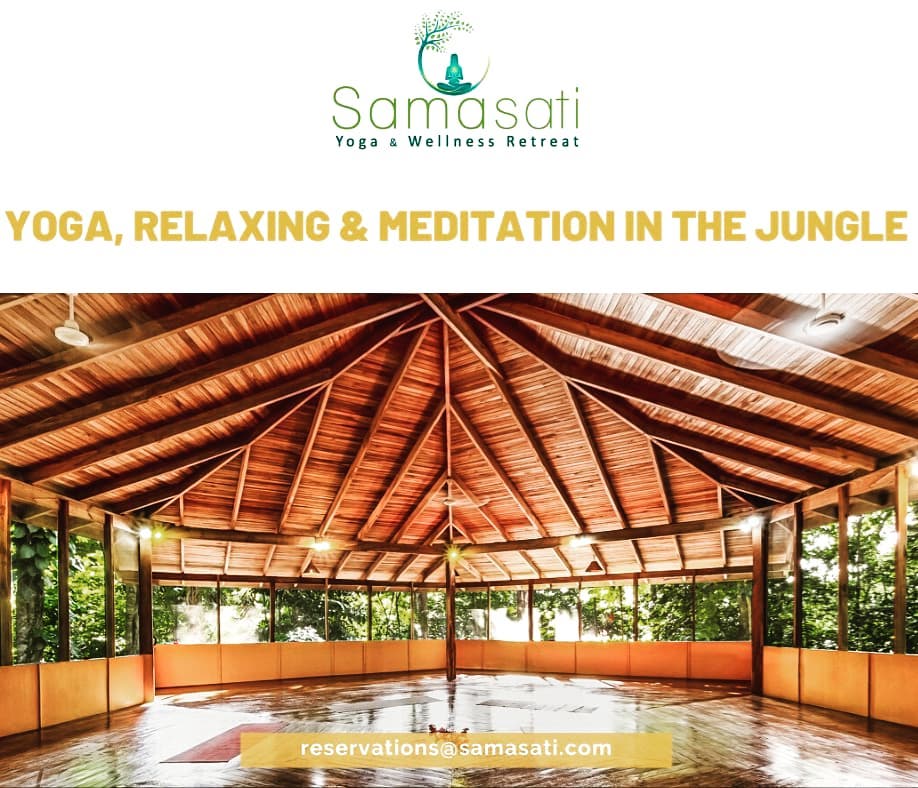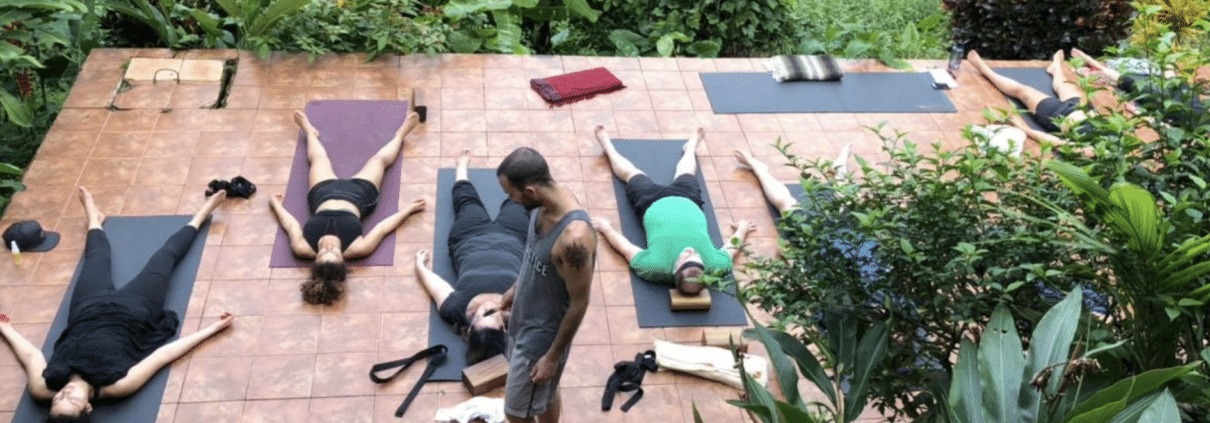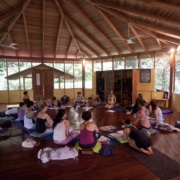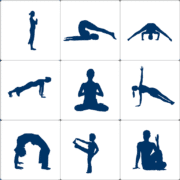How To Plan A Yoga Retreat
During this time of great transition, a yoga retreat can provide a pause to rest. A pause to reflect. A pause to remember the exquisite existence this life truly can be. Life can feel heavy. Transitions can be hard. Even beautiful times bring stress and anxiety. Taking a moment for oneself will always be worth it. Sharing that moment with your community of like-minded souls who have gathered in some unknown land to dance under the moon and sing to the sun will infuse you with the energies of the eternities. When you are called to lead your students further on their journey of self-discovery through a yoga retreat, this guide can help you with the planning of the details.
You will know the time is right to take your teaching on the road when your students repeatedly ask for more. You will know it’s time when you have eight hours of material in mind for your one hour class. When you and your students crave more, then it is time to lead a yoga retreat.
Take a deep breath. You are going to do this. The time is right now. You will have many decisions to make about location, transportation, meals, entertainment, emergencies, documents, deposits…the list can seem daunting. And that is before we even discuss the actual retreat! We want to help make your first yoga retreat as wonderful as you do. Here are 7 steps we’ve put together you can use when you start to plan your first yoga retreat.
Imagine the Experience
Take another deep breath. Then five more. Now imagine yourself at the airport waiting for your return flight. You are reflecting on the wildly successful retreat you just led. You are being critical of the areas you want to do better but all-in-all you’re feeling pretty good about everything. You were able to fulfill all the promises you made to your students turned clients. You facilitated breakthroughs and carried the torch of your teachers who facilitated yours. Everyone was happy and several have reserved spots in your next offering. How did you get here? What transpired to bring you such contentment in your work? What magic did you sprinkle over the week that made it so uniquely your offering? What was the weather like? The food? The accommodations? Was there a pool?
You get the idea. Dream big and in detail. When you feel the picture is near enough complete it is time to find your location.
Choose your venue
The venue you choose can either make or break the experience. Once you have decided what type of environment you feel will be most supportive to your intentions then get clear on the needs of the group. Will your clients feel comfortable in an efficient shared hostel or are they more inclined to feel at peace with an infinity pool and room service? Wherever your clients land on the accommodations scale, it is important that you know.
Look at all the venues you are drawn to in the area you want to take your retreat. Most venues that are dedicated to hosting yoga retreats will have a group liaison on staff. This liaison will be an invaluable source of information. First, reach out to each venue. You will notice your interest will be drawn to one or two in particular. Reach out to these first. Connect with the liaison and ask questions. These venues might also provide you with a retreat planning checklist and other helpful information for group leaders.
Remember your dream retreat and keep it in mind while asking your questions and finding out information. Ideally, you would visit the venue prior to bringing your clients. However, if that is not feasible, then utilize your new relationship with the liaison.
Price your retreat
Another deep breath. Five more. Now let’s discuss pricing. Sometimes it can be hard to remember that teaching yoga and leading groups is work. Unless you’re the one doing it. Then you know the time, dedication, practice, expense, focus, practice, more practice, and physical effort that goes into everything you offer. How does one place a price on the ability to weave a yoga sequence together that will change someone’s life by opening their hips or their heart? Well, there is a formula. First, list your hard costs such as accommodations, food, drinks, local transportation, shuttle from the airport to hotel and return, taxes, etc. Second, decide what else you want to include such as excursions and massages. This is an area to discuss with the venue’s liaison to find out your options.
Consider if these can be offered a la carte to keep the price of your retreat down. Third, count the number of hours you will be offering guided sessions. Pay yourself for these at a rate that is commensurate with the experience you offer. Include paying yourself a commission for coordination before and facilitation during the retreat. Divide your pay among each participant.
Now that the business parts are taken care of it’s time for the fun part which is planning the actual retreat experience.
Create An Itinerary For Your Retreat
Curating the perfect retreat experience will depend on your intentions, your choice of venue, and your budget. Being clear with your intention will help you make the plethora of decisions that come with planning a retreat experience. This will also help you tailor the itinerary to allow for the actual retreating part of a retreat. You do not want your clients going home tired from their vacation. It is important to provide plenty of space in the daily schedule for simply being.
With your intention in mind, connect with your venue liaison. They will be able to give you an idea of what is available onsite as well as in the area. They will also have invaluable insight from other groups’ experiences. They will be able to provide you with the daily operations schedule for the retreat venue. This is important to know as you map out each day particularly if the venue is providing meals, local transportation or programs.
Begin your itinerary with meal times. Most retreat venues provide catered meals for groups. Ask the liaison when meals are available. With this information, you have the base for your daily schedules. Add your sessions. Typically a yoga teacher will offer a morning and evening practice session. Depending on your intention, you may offer other sessions throughout the retreat.
A favorite aspect of most retreats is bodywork. Find out your options and either include bodywork as part of the experience or provide information to your how they can provide that for themselves.
Group excursions are almost always super fun and offer a casual environment for bonding and memory making. Include one or two group activities that support your intention. An example would be to include ziplining if your intention is to help alleviate stress and anxiety through adventure. Or maybe it’s taking a cooking class featuring local cuisine with your groups dietary inclinations highlighted. Ask the venue liaison what activities are onsite and included in your reservation.
Open and close your retreat with a special meal. Your venue will either have options they can offer or will be able to give suggestions. Choose a dress code that’s fun and encourages movement towards fulfilling your intentions.
The first and last days will include arrivals and departures. Check in with the operations of your venue to understand how they assist on these chaotic days. Be prepared to attend to your clients while they navigate these transitions. Considering your personal arrangements prior to start of your retreat. A retreat is a wonderful way to indulge your students turned clients with more of what they love about your offerings. It is also a tremendous amount of work for the leaders. Be aware of this and have a plan to take care of yourself.
Here is a sample itinerary from a yoga retreat in Costa Rica:
| Saturday 13 | Sunday 14 | Monday 15 | Tuesday 16 | Wednesday 17 | Thursday 18 | Friday 19 |
| 6:30am
Yoga |
6:30am
Yoga |
6:30am
Yoga |
6:30am
Yoga |
6:30am
Yoga |
6:30am
Yoga |
|
| 8:00am
Breakfast |
8:00am
Breakfast |
8:00am
Breakfast |
8:00am
Breakfast |
8:00am
Breakfast |
8:00am
Breakfast |
|
| 10:00am Intro to Ayurveda | Massages&Ayurvedic Consult | Massages | Massages | Massages | ||
| 1:00pm
Lunch |
1:00pm
Lunch |
1:00pm
Lunch |
1:00pm
Lunch |
1:00pm
Lunch |
||
| 4:30pm
Orientation |
Massages&Ayurvedic
Consult |
Massages&Ayurvedic Consult | Massages | Massages
4:00pm Pranayama |
Free Time | |
| 5:00pm
Yoga |
5:00pm
Yoga |
5:00pm
Meditation |
5:00pm
Yoga |
5:00pm Meditation | 5:00pm
Yoga |
|
| 7:00pm
Dinner |
7:00pm
Dinner |
7:00pm
Dinner |
7:00pm
Dinner |
7:00pm
Dinner |
7:00pm
Dinner |
Begin by brainstorming possible activities
Make a tentative schedule of all the events in order, with time slots allotted
Break down these events into specific days or times, adding any notes about necessary materials
Plan Your sessions
Now that you know what your retreats itinerary looks like you can dig into the details of your sessions. Plan to offer a twice-daily session on most days of the retreat. The first and last days typically will only have one session because of the schedule. A seven-day/six-night retreat can potentially have 12 practice sessions along with other classes. However, this is the heart of why your students turned into clients. This is the place where you reveal your intentions and guide your clients deeper into the experience of themselves.
Keep in mind the mix of participants and ensure that your offerings are inclusive to everyone on this journey with you. COnside the retreat as a whole and link your sessions to build on one another. Prepare a special offering for the opening and closing night. Ask your venue what options are available for live music, fire pits, DJ’s etc.
Trust yourself in the planning of the sessions. This is what you do best.
Promote Your Retreat
Marketing your yoga retreat is essential for success. Aficionados of yoga are always looking for new venues and experiences and will be happy to learn about yours, so make sure you promote it. It can be a daunting task but we hope these pointers will ensure that it doesn’t take up too much of your time or money.
First, you’ll need to decide on the type of event you want to organize and where you are going to locate it and find out if any similar events have been held there in the past.
Second, think about how people will find out about your event. You might find the following list useful:
a) Build a mailing list and send out regular emails about your event. You can use Mailchimp or other email software to send out regular emails. Consider sending your emails on Monday and Wednesday to increase the open rate.
b) Create both physical and digital flyers and distribute them to as many people as possible
c) Build a website using WordPress or other platforms such as Squarespace or Wix
d) Facebook, Instagram, Tik Tok and Youtube pages for your retreat
e) List your retreat on popular yoga directories such as WeTravel
Communicate with your attendees
Personally reach out to your longtime students. They will be the first ones to sign up for your retreats. They will also be your best promoters. Give them a call, a text, and email with a personal message letting them know you are expanding your offerings. Consider giving them a discount for their dedication. Provide them with VIP services such as a first peek at the itinerary or first dibs on massage appointments.
Your newer students can be informed with an email newsletter. Include all the information you have to help them plan their personal experiences. Oftentimes your venue will provide a What to Expect guide for their facility and area. Include pictures and links to the venue. Also include information on outside opportunities each participant may provide for themselves during the retreat.
Keep up with your personal communication with each participant from registration through follow-ups. Consider creating a WhatsApp group or other online chat where participants can ask questions and share ideas.
Some venues are offering Zoom calls with you and your clients to answer questions about the venue, the area, local transportation, and more.
Include the venue liaison in your communications so they can offer support to your clients with additional questions.
Once people have signed up for your retreat you need to communicate with them regularly so they know exactly what to expect. The key is to be clear about the expectations of the retreat; how much time they will need and what supplies or equipment will be needed. This way, there won’t be any confusion or frustration at the last minute.
Your participants want information, so be sure to give them all of the details necessary for a successful retreat experience. -Keep an open line of communication throughout the process so that questions or concerns will be addressed quickly and clearly. Set expectations early on so that there’s no room for guessing or speculation.
Conclusion
The time it takes to give your attention to the details of your retreat offering will be worth it. All the seemingly tiny decisions will have a big impact on your clients and their experiences. Stay true to yourself and your intention and you will always make the right choice. Planning your first retreat is exciting and daunting at the same time. Consider offering your first retreat close to your community for a long weekend. When you and your clients are ready just add travel to the plan and you’re off to a great adventure.
You will know the time is right to put your energy and efforts towards a retreat.
You will learn more about the process along the way. That part gets easier.
May this guide serve as a starting point for you and your new expanded offerings.











